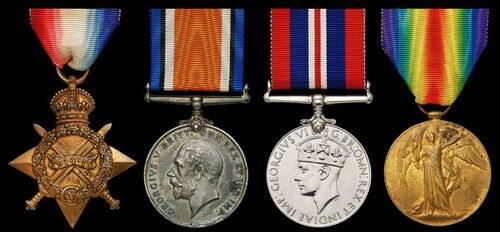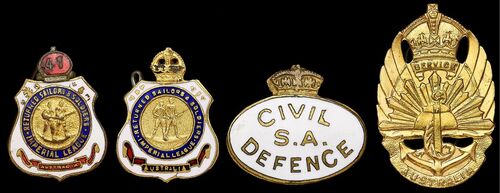Auction: 23112 - Orders, Decorations and Medals - e-Auction
Lot: 517
(x) Four: Captain A. B. Collyer, 2nd (Prospect) Battalion, Volunteer Defence Corps (Civil South Australia Defence Force) late Sergeant, 27th Battalion, Australian Imperial Force
1914-15 Star (1519 Pte A. B. Collyer. 27/Bn A.I.F.); British War and Victory Medals (1519 A-Sjt. A. B. Collyer. 27Bn. A.I.F.); War Medal 1939-45 (S1188 A. B. Collyer), minor edge bruising, very fine overall (4)
Alick Bayman Collyer was born at Watford, Hertfordshire, England and worked as a salesman in Australia before enlisting on 8 March 1915. Taken on the strength of the 27th Battalion as part of the 1st reinforcements on 27 August 1915 in Egypt he saw service in Gallipoli. After the evacuation Collyer spent some time in No. 15 General Hospital in Alexandria before rejoining his unit.
Posted to France Collyer remained with his unit, suffering a serious gunshot wound to the shoulder on 4 October 1917. He was evacuated to England aboard the St. Andrew 6 days being given Depot duty with the rank of Acting Sergeant. Discharged on 7 December 1919 Collyer returned to Australia aboard the transport Plassy.
On the outbreak of the Second World War Collyer joined the Australian Instructional Corps with the rank of Sergeant. Posted from there he was posted to the 2nd (Prospect) Battalion Volunteer Corps force, being commissioned Lieutenant with them on 17 March 1942. Appointed Adjutant and Quartermaster with this unit on 17 March 1943 Collyer was further advanced Captain on 23 November 1943.
The Volunteer Defence Corps was commanded by Inspector-General Harry Chauval, which at its height was composed of almost 100,000 men modelled around the Home Guard. The South Australia Volunteer Defence Corps was formed of 10 Battalions focused around Keswick Barracks with a focus on manning coastal defences and static weapon implements.
As the war moved further from Australia's shores the V.D.F. transferred their services from shore defences to manning searchlights and anti-aircraft batteries with training ceasing to be mandatory in May 1944. Around this time Collyer began to suffer from mental fatigue, he was admitted to No. 105 Australian General Hospital with debility. He resigned his appointment on 13 July 1944; sold together with four original badges comprising an Australia Service Badge, two Imperial League Returned Sailors & Soldiers enamelled badges and a Civil S. A. Defence enamelled badge (No. 61418).
Subject to 5% tax on Hammer Price in addition to 20% VAT on Buyer’s Premium.
Sold for
£160
Starting price
£100







